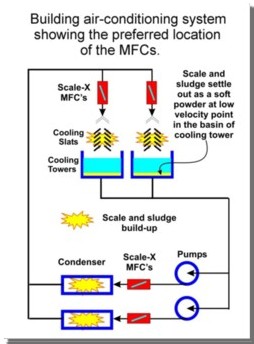|
|
|
|
The application of Scale-X fluid conditioning technology
using Magnetic Fluid Conditioners (MFCs)s is dependent
on a number of factors including the type of scale,
severity of the scale problem and the number of scaling
points. |
|
All water systems which involve heat transfer, evaporation or
pressure reductions, (such as, heating and cooling systems,
boilers, etc.), suffer from potential scale build up of mineral
salts such as calcite, aragonite, gypsum and dolomite, that is,
calcium and magnesium mineral salts. Steel pre-treatment fluid
process systems suffer from severe scale and sludge build-up
problems which are made up of a composition of the elements in
the steel pre-treatment fluid, for example, zinc phosphate. The
petroleum and gas industries suffer from the build up of both
inorganic scale such as calcite and barium sulphate and also
form organic scale such as paraffin, wax and asphaltenes. The
milk processing industry has a similar problem with two forms of
scale build up, these being milk stone (calcium carbonate) and
the organic build-ups of protein, lactose, sucrose and fats.
Scale can be very difficult to remove, and can reduce heat
transfer efficiency, and/or block the flow of the fluid,
resulting in equipment outages to remove the scale.
The energy cost to industry due to decreased efficiency as a
result of scale
build up is enormous. The
increased energy consumption as a function of scale thickness.
If there is biofilm (slime) as well as scale (for example,
calcium carbonate of calcium sulphate, the most common ones),
reduction in efficiency takes place at a faster rate and
increased energy usage is much higher.
Scale-X MFCs can stop new scale and biofilm from forming.
Scale-X can also remove pre-existing scale and biofilm. The rate
of removal is dependent on the magnetic susceptibility of the
scale and also the velocity of the fluid being high enough
("scouring velocity") to wash away the softened scale. This may
take weeks to months. Where the
velocity through the tubes of a heat exchanger or condenser
is too slow then scale deposition is unavoidable.
Scale-X MFC's produce a scale-inhibiting effect that continues
down-stream of the treatment location. Where there are a number
of changed conditions in a fluid process system, such as heating
processes where there is evaporative concentration, or where
pressure reductions occur which results in changes in the
dissolved compounds content of the fluid and release of
dissolved gases (for example, CO2 in crude petroleum
production), multiple stages of Scale-X devices may need to be
applied. An example of
dissolved
CO2 release is given in the accompanying graph.
|
|
Fluid velocity particularly in heat
exchangers / condensers..
|
|

It is
preferable that the designed velocity of the fluid
through the HE tubes is a least 1.5 metes per second.
It is important that the fluid
velocity in heat exchangers and condensers be maintained at
greater than 1 meter per second. This is to ensure that
the softened scale particles do not begin to settle out due to
slow flow. If the velocity is allowed to fall below 0.6
meters per second then sludge will begin to accumulate in the
heat exchanger tubes and elsewhere.
|
|
|
|
Locating the MFCs for maximum effect.
|
|
The Scale-X MFCs are usually located as close as possible up
stream of the scaling point, for example, just prior to entry to
the heat exchanger, the condenser or evaporative point is the
system where gas release takes place due to pressure reduction,
etc... Release of dissolved CO2 causes major scale
problems. The following example shows where MFCs are typically
located in a building air-conditioning system.

Locate the MFCs just up stream
of the vessel with the scaling problem.
Where there is a
series of
minor scaling points a single MFC may cover all of them.
However,
once the "magnetic energy" created by the MFC is
exhausted, then scale will begin to form again.
One way of assessing the severity of a scale problem is by
the rate at which the system fouls, hours, days or weeks.
Systems where the scale forms over a number of days such as
air-conditioning systems, the scale problem can be totally
eliminated allowing the system to then run continuously with
cleaning - except for the cooling tower basin where the soft
scale and sludge settles out at the slow flow point. The
basin will require regular flushing, the soft scale must be
flushed out before it is allowed to dry as it will then harden
again.
In systems where the scale forms within a few hours, for
example, milk concentrators, the rate at which the scale forms can be
slowed/reduced but not totally eliminated. However, cleaning is usually much faster
and requires less detergents as the scale that does form is
reduced and soft making cleaning easier. Also in such
systems as the dairy concentrators (evaporators), thermophiles
and anaerobic spores are reduced as their food source is delayed
and reduced.

|
|


